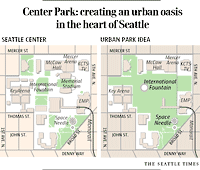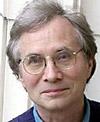Center Park: It's time to create a glorious urban park at Seattle Center

Seattle Center is at a crossroads — yet again. The Sonics may be departing KeyArena, or forcing another expensive remodel. Some major buildings and the amusement park have reached the ends of their useful lives. Center Director Virginia Anderson, a crucial leader for the past 18 years at the center, retires this month. "All the cages are open," says the board president of one key user of the center.
This time, we should do more than apply Band-Aids to the chronically underfunded Seattle Center. We should get it right. We should make a spacious and glorious urban park at the heart of the center.
The Mayor's Task Force on Seattle Center Financial Sustainability, which has been studying the issue for a year, has come up with proposals that largely patch up the status quo. However, the $300 million price tag for remodeling both Center House and KeyArena will be a very hard sell.
This is not to minimize the accomplishments at the center during Anderson's remarkable tenure as a gifted leader, fundraiser and project manager. She took over a very troubled place in 1988, in the wake of Mayor Charles Royer's failed Disney scheme for the center. She stabilized operations, built numerous handsome facilities such as Fisher Pavilion and McCaw Hall, and attracted new tenants and residents such as the Experience Music Project and the Bill & Melinda Gates Foundation. It's fair to say that she saved Seattle Center.
Anderson, a former developer, set about adding programs, buildings and customers. She expanded attractions during off-season and daytime. She made the culture center more populist, particularly with the many ethnic festivals. This broadening of the political base made it possible for the center to pass levies to fund upgrades.
Now it's time for a different paradigm, one reflecting changing urban priorities.
Instead of adding more attractions in a kitchen-sink approach, we should strategically subtract worn-out, money-losing buildings and uses. Above all, the center needs a defining and compelling central vision to shape its next 25 years. That core idea is obvious and has often been proposed. Seattle Center should be our major downtown park.
This time, so many planets are lined up that the park paradigm may finally happen. The Seattle School District's Memorial Stadium is decrepit and fixing it up will cost millions the district doesn't have. The wheezing amusement park, the Fun Forest, is ready for retirement. Mercer Arts Arena, another dusty relic, is closed and unsafe for public assembly. The neglected old monorail, currently laid up, needs as much as $15 million for a new station and to keep it running. Conference facilities in the Northwest Rooms and in Center House are uncompetitive. Center House and possibly even KeyArena, if the Sonics decamp, may have outlived their economic usefulness.
Take away most of these buildings and presto! — a long-sought goal of the city appears, a major downtown park.
"Center Park," in turn, meshes well with new agendas for downtown Seattle, such as the desire to increase downtown living dramatically (by adding amenities like parks), and the need for more open space for summertime concerts and festivals. There are also some new sources of money for Center Park, notably developer fees and the continuation of tourism-based taxes now used to fund stadiums.
By "urban park," I don't mean to suggest a passive, placid greensward. The theaters along Mercer Street and the museums clustering on the south side, along Broad Street, would all remain, as would the Space Needle and the International Fountain. Thanks to the proximity of lively urban villages like Uptown (Lower Queen Anne) and Belltown, the park would be crisscrossed with workers, residents, children, tourists and plain old people-watchers.
The models would be some of the world's most-beloved spaces, such as Boston Common or Paris' Luxembourg Gardens, to cite two examples each about the same size as the 74-acre Seattle Center. Such splendid public spaces are busy from the early morning exercisers and dog walkers to the strolling couples at twilight. They have amphitheaters for free music, marionette theaters, gardens, sculpture, spaces for festivals and vendors, boat basins and play equipment for children, all-weather cafes, outdoor skating rinks, used-book stalls, nearby museums and performance venues — the full urban, democratic blend. Opening up so much new parkland — Center Park would be five times the acreage of the Seattle Art Museum's new Olympic Sculpture Park, for instance — creates room enough for big activities and serene walkways.
By linking this new park with SAM's nearby sculpture park and the new South Lake Union Park, Seattle would suddenly and dramatically make up for its serious lack of spacious, beautiful, vital downtown parks. Connected by bike and walking trails, as well as by a possible streetcar, these three parks would anchor new residential and commercial districts. North downtown would have three splendid parks: one for sculpture on Elliott Bay, one for culture at Center Park, and one for history on Lake Union.
Seattle Center as a park is an old idea. Paul Thiry, the architect of the original Coliseum and the designer of the 1962 World's Fair grounds, said, "Seattle Center is planned to be a magnificent park." His scheme for converting the fairgrounds would have removed Memorial Stadium and created acres of open space. An imaginative scheme in 1984 by David Hancocks (who transformed our Woodland Park Zoo) and fellow architects Grant Jones and Gordon Walker envisioned a three-block "Commons," as well as (and this has happened) a sculpture garden along the Broad Street section.
Several factors torpedoed the park paradigm. Proud of throwing a World's Fair that made money, city leaders in the early 1960s insisted that the center keep any uses that could pay rent, such as (despite howls from the arts groups) the tacky amusement park. Over the years, mayors and City Council members have injected their pet projects onto the grounds, often at low rents. The clash of conflicting uses — basketballers and balletomanes — was rationalized as a charming display of Seattle inclusiveness. The park idea got lost in the cacophony.
Another problem is that cultural and civic complexes like Seattle Center are usually surrounded by parking lots and major highways, which stiff-arm the nearby neighborhood. This, too, is finally changing, notably with the Gates Foundation's plans to build a large campus alongside the eastern edge, replacing acres of ugly surface parking with a large new daytime workforce and a handsome new garage. Condo and apartment developers are swarming onto former parking lots. The neighborhoods are finally cozying up to the center. (For another illustration of POD — park-oriented development — take a look at all the condos going up alongside SAM's new sculpture park.)
These regular users, like the residents and students and workers thronging New York's Washington Square, are the lifeblood of an urban park. Now, three surging urban villages are converging on Seattle Center — Lower Queen Anne to the west and north, Belltown to the south, and South Lake Union to the east. They need a park, just as an urban park needs them.
Add the neighbors, and Seattle Center can scale back its expensive strategy of importing tourists and suburban customers. Today, only 25 percent of center patrons live in Seattle, according to a recent study. Traffic congestion and suburban competition in the arts are making that import strategy harder to sustain. So it makes sense to subtract the attractions that produce large surges of traffic, such as basketball games. Nearby, devoted, frequent patrons of the park are much better stakeholders than remote and indifferent visitors.
Can we pull off this exciting vision? It won't be easy, given all the powerful interest groups at the center. Seattle normally finds it easier to do a dozen things pretty well than one big thing extraordinarily well. (That's changing: just look at the new Central Library or the sculpture park.) Center Park would provide a defining and organizing theme for Seattle Center that will re-excite us about the neglected legacy of the '62 World's Fair. It will also boost many other causes — the nearby neighborhoods, the push for downtown living, the cultural institutions at the center, and (by tapping new funding) Seattle Center's troubled bottom line.
The public, not the cautious government, will have to make it happen. A broad group of us will need to push for this magnetic, big idea. Implementation should be gradual and opportunistic over the next 10 to 20 years. Here are some suggested steps in this morphing strategy:
• Don't foreclose the park option by spending money on fixing up white elephants, such as Center House, that are right in the middle of a potential park and some of whose uses (like the arts-oriented Center School) can be shifted to a new building on the edge of the park. Similarly, don't give away the store to keep the Sonics at KeyArena, since they are not especially compatible with an urban park.
• Focus first on the key problem, removing the School District's worn-out football stadium. The stadium, already excavated, would become the site for underground parking with a park on the lid. In turn, underground parking within the park is a key to filling in perimeter parking lots with apartments and offices.
• Line up new money to support a Center Park. King County, which hopes to have substantial "civic amenities" money from a Sonics deal (or departure), is a key new funder of this regional asset — assuming it likes the park idea. (County Executive Ron Sims has made clear his impatience with the status quo at Seattle Center.) Developers would also have to open their wallets to help maintain the park to high standards. A surrounding park "conservancy" can also provide financial and volunteer support.
• Pick a new director who is open to this new paradigm and has experience with parks.
Large urban parks are a chief glory of great cities all over the world, just as they are the most glaring absence in downtown Seattle. Surprise! We have a half-built park right under our noses. Center Park is just the right size and cradled in an ideal and authentic urban matrix. Let's finish the job.
David Brewster, founder of Seattle Weekly and Town Hall, is president of the Freeway Park Neighborhood Association and serves on the Seattle Downtown Parks and Public Spaces Task Force. He can be reached at davbrewster@comcast.net

